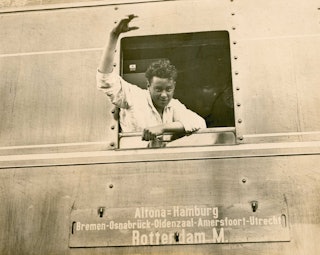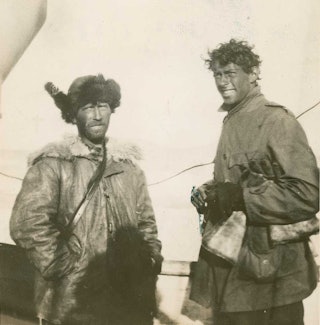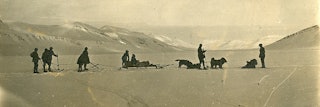Spitsbergen always remained a vivid memory in the life of Sjef van Dongen, even many years later when he became mayor of Aardenburg in Zeeuws-Vlaanderen.
Sjef van Dongen (1906-1973) was declared a national hero in 1928. He became an ‘arctic hero’, who had risked his life in order to save the lives of others. For years, Van Dongen held lectures throughout the country about his experiences. When he became mayor of Aardenburg, ‘Svalbard’ (Norwegian for Spitsbergen) also became of importance to this little town in Zeeuws-Vlaanderen.

Aviation pioneer crashes
During the spring of 1928, a unprecedented drama, which contained all suitable elements for a book and a movie (both were made in abundance after the incident), unfolded. In May 1928, Umberto Nobile, pioneer of aviation and his fox-terrier Titina, along with fifteen crewmembers, who were also aboard the airship ‘Italia’, had crashed near Spitsbergen.
During these years an international race to be the first person on the North pole had begun. In 1911, Norway had received the honor of being the first person to reach Antarctica, thanks to Roald Amundsen. Captain Nobile wanted to land on top of the North pole, in order to claim the eternal glory of this achievement for his home country, Italy.
Dutchman at Spitsbergen
Suddenly the race of being the first ones to save Nobile and his crewmembers had started. Besides saving human lives, political interest was also at stake during this rescue mission. The fascist regime of Italy was not planning on letting its citizens be saved by other countries. Most of all, they did not want their citizens to be saved by communist Russia. Meanwhile, famous travelers of the arctic region and aviation experts, military personnel from army units from various countries and a small congregation of camera operators, photographers and journalists assembled on Spitsbergen.
Amidst this exotic mix of nationalities and personalities, was also ‘a fierce Dutch boy’, as he was later described in the Dutch press. His name was Sjef van Dongen, 22 years old, and the only Dutch citizen of Spitsbergen. At Spitsbergen, Van Dongen was employed by a Dutch coal mining company. Furthermore, the happy and sporty young man was known for his abilities to train and control a dog sled, as a consequence his dogs were used in many arctic expeditions.
An expedition full of dangers
Sjef van Dongen didn’t hesitate when the governor of Spitsbergen had asked him to start a recue mission. He and the Italian Alpine captain Gennaro Sora left immediately on a sled pulled by nine dogs. The expedition proved to be very dangerous; in order to survive some of the dogs were used as food.
Declared dead
Nobile, his little dog Titina and some crewmembers were eventually rescued (by the Swedish and by Russians). Van Dongen and Sora also had to be rescued. The newspapers had already given up on their chances of survival and had already declared that they had died, when the Russian icebreaker ship ‘Krassin’ had spotted the two men. Swedish and Finnish pilots while risking their own lives, managed to rescue Van Dongen and Sora. However, not everyone was able to return alive, several crewmembers of the ‘Italia’ and the crewmembers of two other rescue planes, one of which included the famous Roald Amundsen, had not survived.
Van Dongen’s adventures were published in newspapers worldwide. The dog sled expedition by Sjef van Dongen and the Italian Alpine captain Gennaro Sora became a front-page story in a variety of newspapers all around the world, including America and even Australia. When van Dongen returned to the Netherlands, he was welcomed home as a national hero. He was overwhelmed with honors, awards, ‘fan mail’ and gifts.

Zeeuws-Vlaanderen
The events and experiences on Spitsbergen shaped the life of Sjef van Dongen, who moved to Zeeuws-Vlaanderen after he got married. He also became a member of the Dutch resistance during the Second World War and contributed as mayor of Aardenburg and politician significantly to the reconstruction of Zeeland, which was so heavily destroyed during the war. It goes without saying that his reconstruction efforts were aimed more specifically on Zeeuws-Vlaanderen.
Spitsbergen remained a vivid memory in the life of Van Dongen. Even many years after the war, he still continued giving lectures about his arctic adventures throughout the country. The sports park of Aardenburg which was named in his honor, was financed with the money he had earned from his lectures. His name was also used for the tennis club S. J. E. F., which was also an abbreviation of ‘Steeds Jong En Fit’ (Always Young and Fit), which perfectly suited Van Dongen’s own character.
Archive Sjef van Dongen
The personal archive of Sjef van Dongen further elaborates on the role of the media. The documents also provide an intriguing point of view with regard to his own rescue mission and daily life between the ice and the snow at Spitsbergen. The archive of Sjef van Dongen can be accessed at the Zeeland Archives. The diary that Van Dongen kept during his rescue mission, has also been added to this archival collection.
